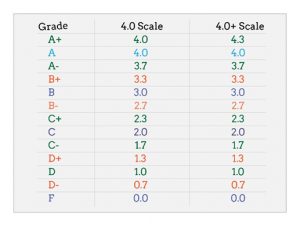Grade Point Average (GPA), we haveve all had to deal with them, and you probably have questions like:
- Is it too low to get into that great school?
- How can I raise it? Do I have time?
- Or if you are like many students out there…How do you calculate the dang thing, anyway?
Well, that is why this article, and our expertise, is here to help. We are here to break down nonsense, and help you crunch the numbers so you know where you stand academically.
GPA Formula
How GPA was calculated?
We all roll our eyes when our parents, or grandparents use the phrase, “When I was a kid, things were simpler…”. In a lot of cases, things weren’t simpler or better, just different. In the case of education, tests, and GPAs, it turns out they are right. Way back in the day, GPA’s were calculated on a simple scale with A=4, B=3, C=2, D=1 and F=0. Anyone with a positive number for an IQ could calculate their GPA quickly in their head.
Those days are gone.
We can’t complain too much though, because remember grandpa walked two miles up hill both ways in the snow just to get to school!
No need to freak out, however, as we are about to show you what it all means, and how to get the number you need. So you can figure out if you will be filling out college or Burger King Applications.
Simple GPA
Besides 8-track tapes, the other archaic thing your parents used when they were young was the good old fashioned letter grade system, also known as a simple GPA. In its easiest form, an A=4, B=3, C=2, D=1, F=0. For each class you have, you assign the correct number to the letter grade, add all of your grades together and divide by the number of classes you have taken.
Slightly Less Simple GPA
For schools that want to make it only slightly more annoying, they sometimes expand on the simple GPA by throwing a + or – by your letter. This means, you might need to whip out a calculator. It’s a cruel system, I know.
If you assume that A is a perfect grade, and some schools do, then the new scale will be:
Using this scale, a perfect GPA would equal 4.0. If you assume that an A+ is better than the perfect A, and some schools do, the scale you use will be as follows:
Using this scale, a perfect GPA would equal 4.33.
Weighted GPA
Some schools choose to really amp things up with a weighted GPA. Hey, they have to make it difficult, or you didn’t really earn it. The next curve ball in the GPA game is the idea that the number of credits each course is worth, will determine how heavily it affects your GPA. Many schools factor in the number of credits each course is worth, meaning a 4-credit class more value than a 2-credit class.
Suppose your schedule looked something like this during your junior year:
Looking at the above we can see a three things.
- You’re most likely the brainy type, and your athletic career isn’t going to go far…
- You earned 13 credits for the year.
- The number in parentheses is the numeric value of your letter grade is unweighted.
To find your GPA weighted by credit hours, follow these steps:
- Multiply each numeric grade value by the number of credits the course was worth
- Add these numbers together
- Divide 45 by the total number of credits you took, in this example,13.
- Your Weighted by Credit Hour GPA = 3.46
In comparison, if you weighted these grades using the Simple GPA method above, your GPA would be 3.29.
Weighting Your GPA With AP/IB/Honor Classes
For those among you that are overachievers, and will be adding AP, Honors, or IB classes to your schedule, first off bravo on the ambition. Secondly, you will need to do some extra calculation, but you’re probably OK with that, being the kid who takes AP classes. Stand tall overachiever, geeky is the new sexy!
It is important to check with your school though, to find out exact rules (some students must take and score a 4 or 5 on an Advanced Placement exam before their grade will be weighted in their GPA) for your school.
A Typical scale may look like this:
Let’s look at a report card to see how it works (the math is the same as in the first example) weighting ONLY the AP classes, NOT the credits:
Let’s look at a report card to see how it works (the math is the same as in the first example). Using the Simple GPA method from above, your GPA Weighted by Your AP Classes is:
In comparison, using the Simple GPA scale and method above would give you a GPA of:
Weighting Your GPA with Credit Hours AND AP/IB/Honors
Finally, let’s use the same report card as in the above example, only this time we will bring the whole thing together, and factor in credit hours AND credit for AP classes:
This may all seem extremely boring, and we get it. Learning what GPA stands for might seem like a waste of time, let alone calculating it, but you’ll find out quickly how helpful it is.
Your GPA makes a statement about not only your work ethic, but your dedication to learning. Of course this doesn’t mean that you must have a 4.0 to go to college, admissions takes a lot of variables into account, but it does matter. After all, if you don’t take your education seriously, why would anyone else?








